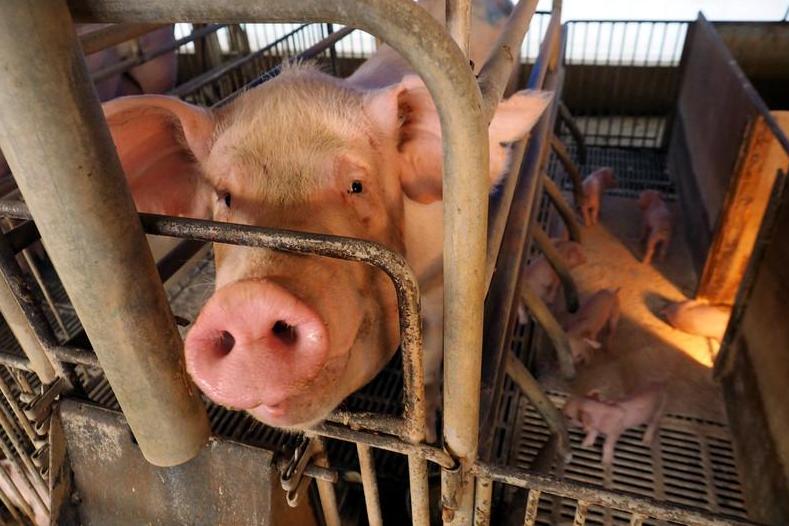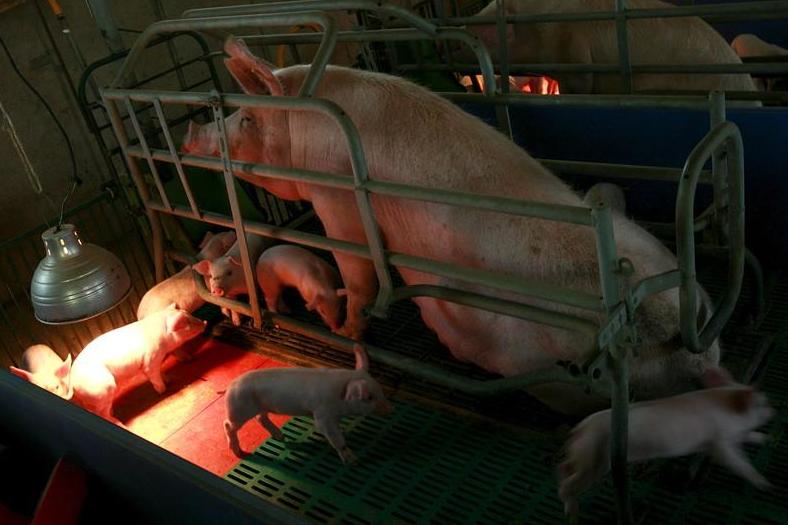Pigs ‘burn from the inside out’ in gas chambers: Why carbon dioxide is the meat industry’s best-kept secret
Every bacon butty or ham sandwich comes at a price: the horrific and hidden suffering of the pigs – animals said to be more intelligent and sociable than dogs. Jane Dalton reveals a harrowing tale


Beloved of builders and considered at least partly responsible for Ed Miliband losing the 2015 general election for Labour, the bacon sandwich has long been a dependable British favourite, alongside tea, the NHS and Marks’s underwear. Yet that age-old filling represents a shocking meat industry secret – and it’s worse than you might imagine. Much worse.
Most of the big slaughterhouses in Britain and Europe do not kill pigs by electrical stunning, which would mean instant death, but by lowering them in crates into chambers filled with carbon dioxide. For at least 15 seconds, the animals thrash about desperately, scream in pain and gasp for breath while the gas acidifies their eyes, nostrils, mouths and lungs.
As the CO2 penetrates their entire systems, they scramble to try to escape, panicking and in distress. The animals literally burn from the inside out, critics say. The suffering sometimes goes on for up to a full minute-and-a-half, according to some.
Most of the pigs slaughtered for food in the UK – 86 per cent, or nearly nine in 10 – are killed by this method. The proportion subjected to death by CO2 is similar in many countries including Denmark, Germany and Spain, while in Sweden, it’s almost all. But few consumers have any idea – prompting claims the system is the meat industry’s best-kept secret.
Described as more intelligent than dogs, pigs have proven abilities to recognise their own names, learn “tricks” such as sitting down to earn treats, and form social relationships as complex as those of primates. Because of their acumen, it’s no wonder George Orwell chose pigs as the stars of Animal Farm, the scheming totalitarian power-grabbers. Pigs can dream, just like our cats and dogs, and in studies have been observed as displaying empathy for others who are happy or distressed.
When intensive factory farming took off in the 1950s, as post-war farmers were given new subsidies to ramp up food production, the number of pigs on British farms started to grow, and the carbon dioxide – a byproduct of fertiliser production – was first brought into slaughterhouses. Within four decades the number of British farm pigs had more than doubled, to 7.5 million in 1990.
Ever since, efficiency drives have created pressure for the mass killing of animals for speed. The carbon dioxide slaughter method involves lowering pigs into “gondolas” filled with the gas, which acidifies the blood and spinal fluid, causing the animals to gradually lose consciousness. The gas mixes with their mucous membranes, causing a burning sensation and an inability to breathe.
In their panic, the pigs gasp for air and show “violent bulking”, as one study put it. Research has also found they suffer respiratory distress, causing hyperventilation and an urgent sense of breathlessness.
In the UK, just under a million pigs a month – an estimated 11 million a year – are slaughtered for food, government figures show. But the benefit of the carbon dioxide (CO2) system is that pigs – who find reassurance in being with their own kind – can be killed in groups, according to the Humane Slaughter Association (HSA), a charity that aims to reduce animal suffering. This way, as many as 800 an hour in large abattoirs.
And research has concluded that another advantage for pork producers is that the meat quality is better than with electrical stunning.
However, those opposed to the use of “gas chambers” say the pigs’ desperate reactions to breathing in the CO2 demonstrate how “exceptionally cruel and inhumane” it is. And carbon dioxide is used because it is relatively cheap for the big abattoirs, and is faster than manual stunning using electrical tongs, they say.
In Australia, where carbon dioxide is also the principal slaughter method, footage obtained by activists this summer showed pigs, sheep and goats locked in gas chambers desperately trying to claw their way out, “fearful and screaming”, according to Emma Hurst, an MP in New South Wales.
“Pigs are forced into gondolas using an electric prodder. Once there, the gondola is dropped into the gas. The carbon dioxide mixes with mucus and forms carbonic acid,” she said.
“Essentially what we are seeing in this footage is pigs burning from the inside out. I can’t begin to tell you how distressing this footage is to watch – but it is nothing compared to the distress these animals go through. Gassing pigs with CO2 is exceptionally cruel and should be outlawed.”
Another study found that while pigs were still conscious, they displayed “lateral head movements, sneezing, gasping, vocalisations, muscular excitation, aggression, neck extension, eye rotation, violent bulking”. Chris Delforce, head of Aussie Farms, which shot footage in the gas chambers, says: “For decades this has been referred to as ‘humane’ by the industry but I think it’s clear to anyone who watches the footage that it’s the furthest thing from humane.”
In the UK, as long ago as 2003, the government’s own welfare advisers recommended that carbon dioxide killing should be banned – but that advice was never taken up. And the following year the European Food Safety Authority also concluded that it was cruel and called for it to be phased out – but again no action was taken. Since then, both the RSPCA and Compassion in World Farming have repeatedly jointly called for alternatives to be made available.

Shoppers may be surprised to know that it’s not only bacon, ham and pork from supermarkets – including products with the Red Tractor endorsement – that comes from CO2 stunning; even some organic pigs may be killed this way, as the Soil Association allows the slaughter method for meat under its scheme.
The association defends its endorsement by pointing out that CO2 is approved by the HSA, although it recognises there are pros and cons of both this method and electrical stunning. “With CO2 stunning, the animals benefit as they stay together as a group with very minimal human contact, which minimises their distress ahead of stunning,” a Soil Association spokesman said.
“However, there are 15 seconds or so of some discomfort for the pigs, which is distressing for them and those witnessing it. With electrical stunning, the stun is more immediate, but the pigs get much more stressed on the way in as they have to be managed single file and a human has to physically administer the stun.”
The HSA also warns of the risk with manual electrical stunning that the animals will not be properly rendered fully unconscious because of human error.
But animal-welfare campaigners – who believe use of CO2 is entirely for the meat industry’s benefit rather than lowering pigs’ stress – point to the HSA website that says: “If a stunning method does not cause instantaneous insensibility the stunning must be non-aversive (ie must not cause fear, pain or other unpleasant feelings) to the animal.”
The Eurogroup for Animals organisation, like the RSPCA and CiWF, has also lobbied for years for the use of carbon dioxide to be halted. “The main reason why we consider the use of CO2 at high concentrations unacceptable for the stunning of pigs is that it is highly aversive for the animals and causes acute pain and severe distress from first exposure to the gas to loss of consciousness,” it says.

The non-profit organisation refers to a scientific study that found “CO2 gas at high concentration is acidic when inhaled, causing severe irritation of the eyes, nasal mucosa, lungs, and an overall painful experience due to the presence of chemoreceptors in the throat (Raj and Gregory 1995).
“The lack of oxygen also causes a severe sense of breathlessness which may cause severe distress.”
Nobody who knows about this slaughter method seems to deny that it causes pigs intense suffering, but until now the length that suffering lasts has generally been considered in the industry as acceptable. Some trials have been carried out on the effects of different degrees of the carbon dioxide in the gas chambers. Under European law, the concentration should be at least be 80 per cent, but many slaughterhouses use 90 per cent to increase their output by killing animals more quickly.
Studies show the pigs lose consciousness sooner with greater concentrations but scientists disagree on whether raising the concentrations makes their deaths less agonising. One found “little reason to conclude on a behavioural basis that these atmospheres are greatly different in their impact on pig welfare”.
It’s not as though pigs are given pleasant lives before their deaths: an investigation in spring by Compassion in World Farming (CiWF) found sows on British farms subjected to misery in farrowing crates where for weeks on end they were hemmed in on all sides by metal bars to spaces that left no room to move around. After giving birth trapped in the metal crates, on slippery slatted floors without straw, the mother pigs were prevented from turning round to nuzzle their piglets.
Meanwhile, opposition to the carbon dioxide chambers goes on. Some campaigners say they are so horrific for pigs that they are as bad as forms of slaughter without stunning: halal and schechita, which are deeply disliked by many people in the UK precisely because of what the animals experience. Philip Lymbery, chief executive of CiWF, says: “The truth is that CO2 killing of pigs is non-stun slaughter.
“CO2 killing, whereby the animals are terrified, fighting for breath, essentially feeling intense pain and suffering from the inside out, for 30-60 seconds or more before losing consciousness, is as much non-stun slaughter as simply cutting an animal’s throat and letting them bleed out. Both are unacceptably inhumane methods of killing animals. There is nothing to be gained in trying to play one cruelty off from another. Both cause immense pain, suffering and distress over a prolonged period.

“Government action is needed to end the use of these methods, both of which cause immense pain, suffering and distress to the animals involved for a prolonged period.”
Another campaigner said the two methods were so excruciating that neither could be described as “less bad” – “It’s like asking which you would rather have: a punch in the face or a kick in the kidneys.”
The industry itself has not managed to come up with alternatives to CO2: while other gases have been tried, they have generally been judged inadequate on either animal-welfare or commercial grounds. Put simply, lower concentrations of the gas mean suffering is less intense but animals lose consciousness more slowly.
The HSA and the Department for Environment, Food and Rural Affairs are funding research into alternatives to CO2, such as low-atmospheric-pressure stunning, which has been approved in Europe for poultry but not pigs. Early findings of the research are due out later this year.
Charlie Mason, of the association, told The Independent that while CO2 was “undoubtedly aversive for a few seconds”, large-scale electrical stunning systems involved making pigs go into single file, which was stressful for them. “Some can tolerate CO2 better than others. They’ve tried using argon, an inert gas. It works but because it only displaces air it doesn’t have any other effect on the PH of the spinal fluid it takes about 10 minutes to kill them so it’s not commercially viable, and is extremely expensive. So CO2 outweighs high-voltage electrical stunning.
"Pigs have to be in the chamber for 90 seconds but they lose consciousness within 15 seconds on average, although convulsions will continue for up to 40 seconds,'' Mr Mason said.
Carbon dioxide’s use posed “a moral dilemma”. Ideally, he would prefer pigs to be electrically stunned in little groups where they were manually stunned and died instantly, not in a fully automatic system that involves single-file restraining conveyors, he said. The association’s technical guidance says that for large operations with high throughput rates (such as 800 pigs an hour), it was often “the most reliable slaughter method for ensuring consistency in terms of good welfare and quality”.
“For the system to be as humane as possible, it is essential that animals are exposed to the maximum concentration of carbon dioxide as soon as possible and that the dwell time is sufficient to ensure that animals do not regain consciousness before death.”

A spokesman for the British Meat Processors’ Association said: “Animal welfare is and always should be a high priority for the industry.” He acknowledged that pigs find high concentrations of carbon dioxide “aversive” and said they “will try to avoid exposure to these”, adding: “In the case of gas killing using carbon dioxide, pigs are seen to exhibit strong reactions for a period of up to 30 seconds.”
But he echoed the HSA’s perspective that some of the reactions are reflex movements after the animal has lost consciousness “and is therefore not a welfare concern. As with many gas killing systems, carbon dioxide partly acts by displacing oxygen so the brain cannot function and brain death ensues. “However, carbon dioxide also has a direct anaesthetic effect which results in loss of consciousness more quickly than with some other low oxygen gas mixtures such as argon and nitrogen mixtures.
“It is a legal requirement to have clearly visible and audible alarms to monitor the gas concentration. These are supplemented by careful observation of the animals. Staff working with these systems are trained to be able to recognise both an effective and ineffective stun/kill and know how to react to them.”
Red Tractor said: “CO2 stunning is a legally permitted method and currently the best practice available.” The Independent also asked the National Pig Association, representing pig farmers, to comment. It did not respond to our request.
Lymbery insists that a population that ate less but better quality meat would support abattoirs to reduce animal suffering at slaughter. “Not many people know how the pig for their bacon, ham or pork died. Carbon dioxide is the meat industry’s best kept – but dirty – secret.”
Join our commenting forum
Join thought-provoking conversations, follow other Independent readers and see their replies
Comments